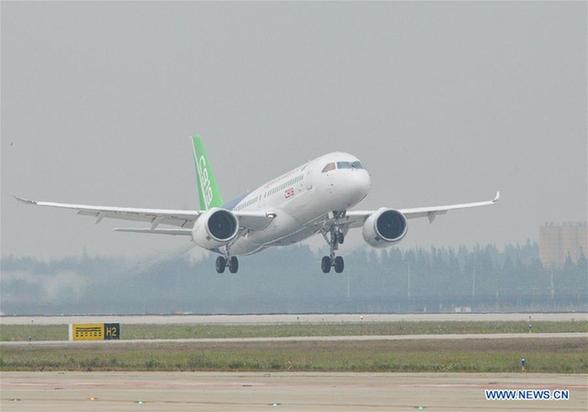China joins the world's aviation premier league
- By Tim Collard
 0 Comment(s)
0 Comment(s) Print
Print E-mail China.org.cn, May 8, 2017
E-mail China.org.cn, May 8, 2017
|
|
|
China's homegrown large passenger plane C919 takes off on its maiden flight in Shanghai, east China, May 5, 2017. [Photo/Xinhua] |
But aviation has so far lagged behind. Thirty years ago Chinese-built aircraft operated internal flights, as well as a number of second-hand planes bought from the then Soviet Union. But gradually, as China devolved her internal air services to a number of separate airlines, they all wanted to be up with the latest technology and bought in aircraft from Boeing and the European suppliers who were to unite to become Airbus.
And this situation was even more acute when it came to international flights: Chinese aircraft technology was little known in the West, and there were a number of safety concerns. So, for some time now China has been dependent on American or European aircraft technology for her domestic and international services.
The decision to aim for equal participation in the long-distance aviation market was taken by the State Council in 2007, and great patience and meticulous research was deployed. Although the first C919 was completed by 2015, intensive testing and quality control was demanded before last week's flight could take place. Anything going wrong might have set China's program back by decades, and this was successfully avoided.
But now the whole world has become confident, through long experience, in using Chinese technology, and so now China has put herself in a position to challenge the existing small group of suppliers of jumbo jets: USA, Europe and Russia. On May 5, the first large Chinese passenger plane, the C919, made its maiden flight from Shanghai, where the manufacturer, Commercial Aircraft Corporation of China (COMAC), is based. Vice Premier Ma Kai and Shanghai's Communist Party chief Han Zheng were present to see the plane depart, on a flight which lasted about 80 minutes. There were no passengers aboard, but the aircraft will be fitted to carry about 160.
The C919 will compete in the international aviation market at the narrow-body, medium-distance level, with the Airbus A320 and the Boeing 737. The standard range will be just over 4,000 kilometres. It represents a technological partnership with existing players in the industry, including General Electric and France's Safran – who built the engines – and the U.S. companies Honeywell International Inc. and UTC Aerospace Systems. This demonstrates that China is not afraid to incorporate foreign technological excellence, and also that Western companies welcome Chinese participation in the market.
Competition, however, will be no easy affair. It is likely to be some time before the C919 makes a serious impact on the international aviation market. Even in the domestic market, China's ARJ-21, the first Chinese home-made jet of the 21st century, took eight years from maiden flight to commercial launch.
China is clearly planning for the long term here, and will not be daunted if breaking into the market takes a few years. Boeing has been in the business since early in the last century and Airbus for over 40 years. A key element in aircraft construction is establishing an absolutely reliable supply chain, and that will take time, especially in an age of lightning-fast technological developments and requirements. China also comes fresh to the business of selling into a market in which other companies are already well established, and are unlikely to make it easy for a newcomer.
There is still plenty of hard work to do, both on the technical and the marketing sides. At the COMAC assembly plant in Shanghai, at the time of the flight, the management hung out banners calling for more hard work, struggle and determination to meet the goals of the company and the Chinese aviation program.
This will be a long and steadily developing business. Of course, as many leading Chinese figures have pointed out, China's need for aircraft, domestic and international, is huge and growing rapidly – and it makes no sense to have to spend billions in foreign exchange sourcing them all from abroad.
No less a competitor than Boeing itself has predicted that China will become the world's foremost aviation market in the next 20 years, needing at least 6,000 new aircraft. And so far foreign and domestic customers, including Air China, have already placed orders for 570 of COMAC's planes.
The absence of a top-quality Chinese long-distance passenger aircraft has been an anomaly in the modern world, and also a great challenge to Chinese technological and innovative capacity. The development of the C919 demonstrates China's determination to compete at the highest level in this difficult but essential market.
Tim Collard is a columnist with China.org.cn. For more information please visit:
http://www.china.org.cn/opinion/timcollard.htm
Opinion articles reflect the views of their authors, not necessarily those of China.org.cn.







Go to Forum >>0 Comment(s)